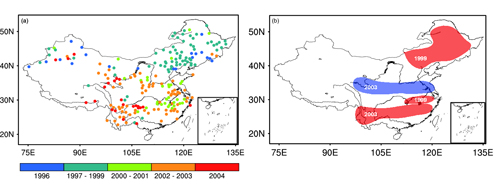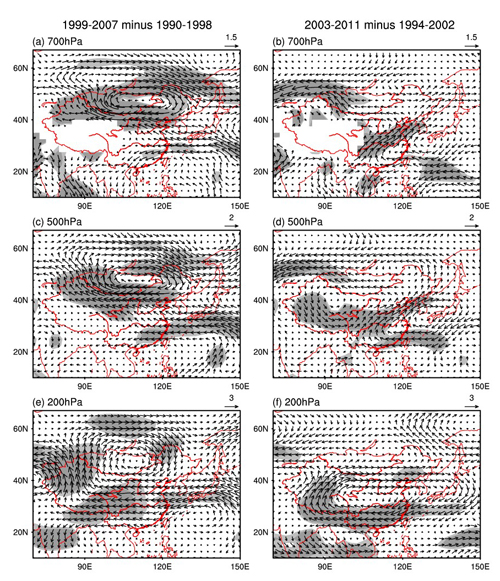Decadal Variation of Summer Precipitation over China after the Late 1990s
Date:2015-05-25
Summer precipitation anomalies can lead to drought and flooding which have significant influence on society and economy of China, so it's important to understand the decadal variation of summer precipitation over China. Previous studies show that summer precipitation over eastern China experienced a decadal variation around the late 1990s. Then, did summer precipitation over western China experience a decadal variation after the late 1990s and what is the spatial pattern of the decadal variation of summer precipitation over China after the late 1990s?
To answer these questions, Dr. XU Zhiqing, Prof. FAN Ke and Prof. WANG Huijun from the Institute of Atmospheric Physics analyzed observation data and conducted numerical simulation. They found that the summer (June-September) precipitation over China experienced different decadal variation features from north to south after the late 1990s. In northeast and North China and the lower-middle reaches of the Yangtze River, precipitation decreased after around 1999. However, precipitation experienced a significant reduction over South China and southwest China and a significant increase over the southern parts of Hetao region and Huaihe River valley after around 2003.

Figure 1 (a) The abrupt change points of the decadal variation of summer (June-September) precipitation over China after the late 1990s detected by the moving t test (MTT); (b) The schematic diagram of the decadal variation of summer precipitation over China after the late 1990s, red color for decreased precipitation, blue color for increased precipitation (figure plotted by IAP)
They next analyzed the associated decadal variation of the atmospheric circulation and identified the possible mechanisms causing the two decadal variations of precipitation. The wind anomalies for the former exhibit a barotropic meridional dipole pattern. There are anticyclonic anomalies over Mongolia to northern China, and cyclonic anomalies over the southeast China coast to the northwest Pacific. For the latter, the wind anomalies show a southeast-northwest oriented dipole pattern in the mid and lower troposphere. There are cyclonic anomalies over the northern parts of the Tibetan Plateau and anticyclonic anomalies over the lower-middle reaches of the Yangtze River to southern Japan. Anticyclonic anomalies dominate the upper troposphere over China south of 40°N.

Figure 2 The summer wind anomalies (units: m s-1) corresponding to the decadal variation of summer precipitation over China around 1999 (a, c, e) and 2003 (b, d, f) at the 700 hPa, 500 hPa and 200 hPa level. Light and dark shading indicates the anomalies are statistically significant at the 0.10 and 0.05 level, respectively. (figure plotted by IAP)
They further found that the summer sea surface temperature warming over the tropical Atlantic played an important role in the decadal variation around 2003 via inducing teleconnections over Eurasia. In contrast, the decadal variation around 1999 may be caused by the phase shift of the Pacific decadal oscillation (PDO), just as previously results shown.
This research has been published in Journal of Climate recently.
Reference: Xu, Z. Q., K. Fan, and H. J. Wang, 2015: Decadal Variation of Summer Precipitation over China and Associated Atmospheric Circulation after the Late 1990s. Journal of Climate, 28, 4086-4106. http://journals.ametsoc.org/doi/abs/10.1175/JCLI-D-14-00464.1
Contact: FAN Ke, fanke@mail.iap.ac.cn
